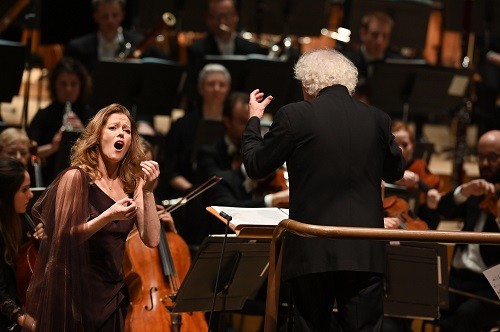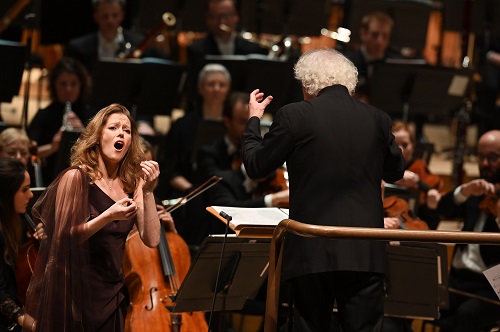 United Kingdom Sibelius, Abrahamsen and Nielsen: Barbara Hannigan (soprano), London Symphony Orchestra / Sir Simon Rattle (conductor), Barbican Hall, London, 10.1.2019. (CSa)
United Kingdom Sibelius, Abrahamsen and Nielsen: Barbara Hannigan (soprano), London Symphony Orchestra / Sir Simon Rattle (conductor), Barbican Hall, London, 10.1.2019. (CSa)

Sibelius – Symphony No.7 in C major Op.105
Hans Abrahamsen – Let Me Tell You
Nielsen – Symphony No.4 Op.29 – ‘The Inextinguishable’
Those contemplating symphonic overload, or anxious about an interminable musical journey through a bleak Nordic landscape, had nothing to fear. The pairing of two mighty symphonies – Sibelius’s dramatic Seventh Symphony and Neilson’s passionate Fourth – framing Hans Abrahamsen’s eerily beautiful song-cycle Let Me Tell You sung by Canadian soprano Barbara Hannigan, made for a programme of emotional intensity, each piece rich and subtle in texture, distinct and varied in style.
Rattle, unleashing the energies of the incomparable LSO, opened with the Sibelius. Predicted by the composer to be the last symphony he would give to the world, the work’s seven movements are welded together and condensed in a seamless, 24-minute arc of glorious sound. From the first shimmering moments of the flowing Adagio, through quickly shifting speeds of the symphony’s subsequent phases, Rattle conjured all the elements of Sibelius’s natural world – the haunting cry of birds in flight, the whisper of wind through trees, and the inevitable flow of ‘a great river’- as Sibelius likened his symphonies, gliding ‘wide and powerful toward the sea’. In a mixture of broad sweeps and gestures of scalpel-like precision, Rattle used his baton to coax a dark opulence from the orchestra’s strings, and a delicate playfulness from the finely balanced ensemble of woodwind players. The LSO’s burnished brass contributed the perfect combination of authority and restraint. Of particular note was the recurring trombone theme, majestically played by Mark Templeton.
The Symphony’s perfunctory and chilling finale in C major has been described as a scream into the void after a time-bending journey. Its abrupt conclusion provided a perfect segue for Abrahamsen’s exquisite three-part monologue for soprano, Let Me Tell You. This powerful contemporary work was composed between 2012 and 2015 and set to a text by Paul Griffiths from his novel of the same name. Based on a series of reassembled phrases spoken by Shakespeare’s Ophelia, Abrahamsen gives us a lament of crystalline purity and staggering originality – the music melding perfectly with the words to suggest Ophelia struggling to survive a frozen, watery world on the edge of madness. Barbara Hannigan, who could be heard last year at Glyndebourne as Ophelia in Brett Dean’s Hamlet, is a coloratura with an icy, almost ultrasonic, upper register and perfect pitch. Her voice, hovering ethereally above the orchestra, blended perfectly with the composition’s instrumental colours, and introduced a mystical quality to lines like ‘What is music, if not time’ and ‘Night, day: there is no difference for me.’ Abrahamsen’s modern take on a 17th-century operatic device known as stile concitato, in which a single note is rapidly repeated to convey agitation, or sometimes – as in Purcell’s King Arthur – extreme cold, was used to great effect.
If the first half of the programme incorporated the elements of water and air, Nielsen’s volcanic ‘The Inextinguishable’ suggested those of earth and fire. Composed between 1916 and 1918, this work was Nielsen’s response to the horrors of the First World War and man’s struggle for survival. In the composer’s own words, he sought to ‘dip right down to the layers of the emotional life that are still half-chaotic and wholly elementary… music is life…and life is indomitable and inextinguishable’. Rattle attacked the harmonic chaos of the opening Allegro with ferocity, brilliantly capturing Nielsen’s clashing resonances and mercurial changes of texture. In the slow Poco allegretto, conflict ceded to a period of precious tranquillity, wonderfully evoked by the LSO’s soothing woodwind, but the lull in battle was soon shattered by the symphony’s third movement – a violent explosion of strings and timpani. A dramatic pause preceded the final Allegro in which a frenzied orchestra and its heavy artillery, comprising two timpanists – the outstanding Nigel Thomas and Erica Ohman – resumed the fight. Even as the work reached its optimistic E major coda, the battering exchange of fire between the two big guns continued. For Nielsen, the promise of hope, however unobtainable, lived on.
Chris Sallon
